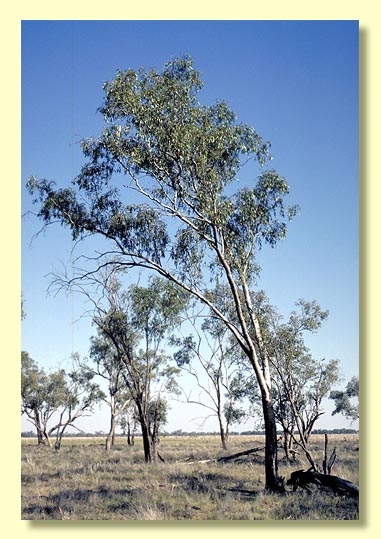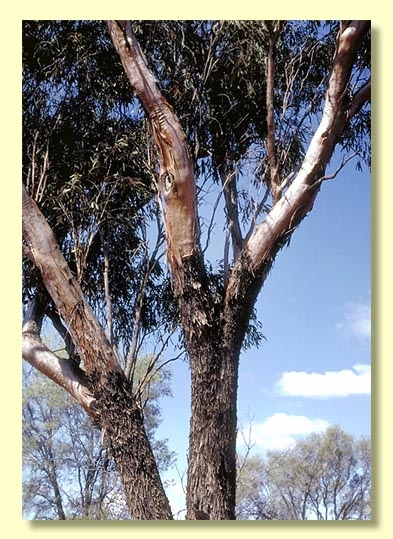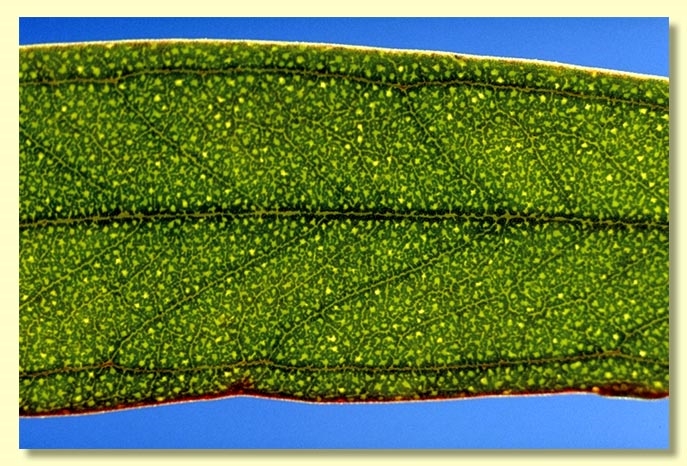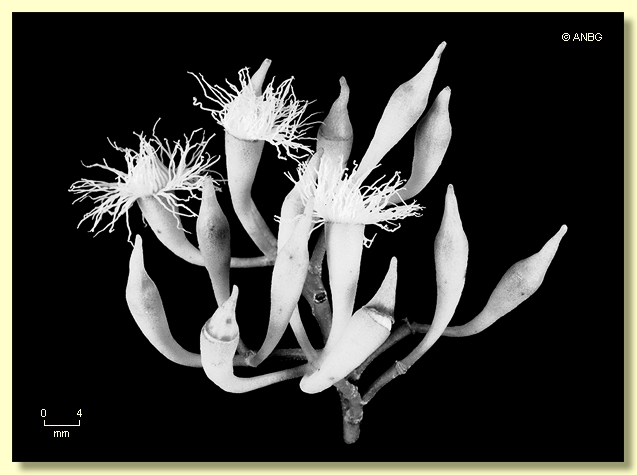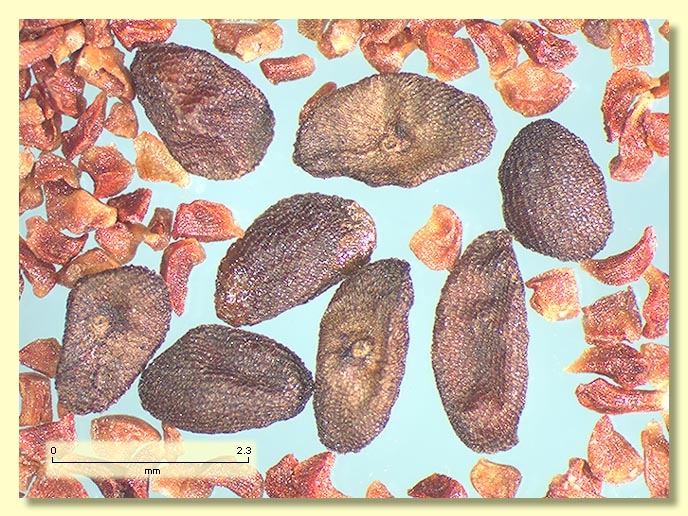Euclid - Online edition
Eucalyptus ochrophloia
Eucalyptus | Symphyomyrtus | Adnataria | Apicales | Coalitae
Eucalyptus ochrophloia F.Muell., Fragm. 11: 36 (1878).
T: ?Paroo River, ?E. Palmer, undated (lecto MEL [MEL703966] fide Bean, A.R., Telopea 12(3): 315-316 (2009).
Bark rough and tessellated, scaly, or box-type on lower trunk, dark grey to black with abrupt change to smooth bark, which is grey to coppery, pink, white, yellow or brown.
Juvenile growth (coppice or field seedlings to 50 cm): stems usually square in cross-section; juvenile leaves shortly petiolate, opposite for 5–8 nodes, then alternate, linear to narrowly lanceolate, 8.5–16 cm long, 0.5–2 cm wide, base tapering to petiole, dull, green to blue-green.
Adult leaves alternate, petiole 1–2 cm long; blade lanceolate, 7–20 cm long, 1–2.5 cm wide, base tapering to petiole, concolorous, glossy, green, side-veins acute, reticulation sparse or obscure, intramarginal vein parallel to and well removed from margin, oil glands island and irregular, or obscure.
Inflorescence terminal compound, or with some single axillary umbels, peduncles 0.4–1.5 cm long, buds 7 per umbel, pedicels 0.5–1.4 cm long. Mature buds elongated, usually curved, oblong to fusiform to clavate, 1–1.7 cm long, 0.4–0.5 cm wide, green to yellow, ribbed longitudinally, scar absent, operculum conical to pyramidal, stamens inflexed or irregularly flexed, with outer staminodes, anthers mostly adnate, basifixed (some filaments taper at tip), cuboid or globoid, dehiscing by terminal pores, style long, stigma blunt or tapered, locules 3 or 4, the placentae each with 4 vertical ovule rows. Flowers white.
Fruit tapering into pedicel 0.5–1.5 cm long, cylindrical to barrel-shaped, sometimes slightly square in cross-section or ribbed longitudinally, 0.8–1.7 cm long, (0.4)0.5–0.8 cm wide, disc descending, valves 3 or 4, enclosed.
Seeds brown, 2–2.5 mm long, flattened-ovoid, sometimes pointed at one end, dorsal surface shallowly reticulate, hilum ventral.
Cultivated seedlings (measured at ca node 10): cotyledons reniform; stems square in cross-section; leaves petiolate, opposite for 5 or 6 pairs then alternate, linear-lanceolate, 8.5–14 cm long, 0.7–2 cm wide, base tapering, margin entire, apex pointed, dull, green.
Flowering has been recorded in May, June, July, August, September, October and November.
A small box tree confined to south-west Queensland and far north-west New South Wales along several river systems, viz. the Bulloo, Paroo, Ward and Warrego. The closest relative of Eucalyptus ochrophloia among the box eucalypts is the more northern species E. thozetiana, from which it is distinguished by the larger, longer buds and fruit. Also E. ochrophloia consistently has a stocking of rough tessellated to scaly dark bark whereas E. thozetiana is usually smooth-barked. E. thozetiana in the southern part of its distribution near Talwood, Queensland, may be rough-barked over the whole trunk but the small buds and fruit distinguish it from E. ochrophloia. These two species differ from all other box species by the lack of distinctly reticulate leaf venation and the extremely irregular to obscure oil glands in the leaves.
In the classification of Brooker (2000) Eucalyptus ochrophloia belongs in Eucalyptus subgenus Symphyomyrtus section Adnataria (the boxes) because the buds have two opercula, ovules are in four rows, seeds are flattened-ovoid, cotyledons are reniform, and anthers are rigid on the staminal filaments. Within section Adnataria, E. ochrophloia, together with E. thozetiana, forms series Coalitae, further distinguished by having buds with the outer and inner opercula united and shed at flowering time, outer stamens sterile (staminodes) and obscure or sparse leaf venation.
Plants in the Eulo, Nokatunga and Moble area of south-western Queensland appear to be intermediate between Eucalyptus ochrophloia and E. thozetiana having buds and fruit too small to be E. ochrophloia and too large for E. thozetiana and with short pedicels.

